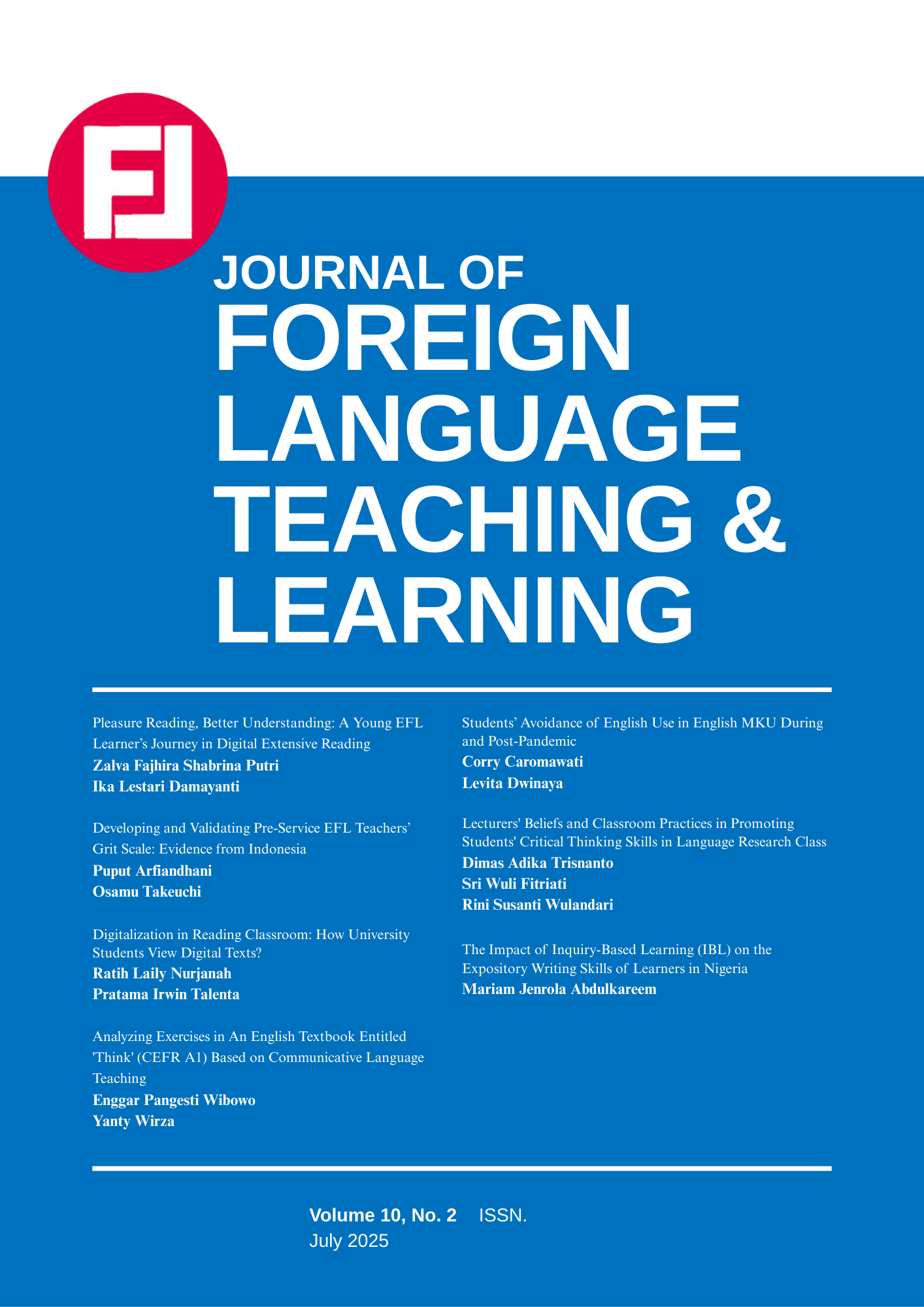Students’ Avoidance of English Use in English MKU During and Post-Pandemic
DOI:
https://doi.org/10.18196/ftl.v10i2.26692Keywords:
Unwillingness to communicate/participate in English, English as a general subject, Activity Theory, Communicative Language Teaching ApproachAbstract
Background: English as a general subject, known as Mata Kuliah Umum (MKU) in Indonesian tertiary education, primarily aims to develop students’ second language (L2) proficiency. These courses are therefore designed to encourage the use English during classroom interactions. However, many students choose to remain silent or resort to using Indonesian instead.
Objective: This study examines students’ unwillingness to communicate/participate in English during classroom instruction, both during and post pandemic.
Methods: It employs the third generation of the Activity Theory as the analytical framework, with the units of analysis being activities across the micro, meso, and macro levels. Using a case study approach, data were collected from multiple perspectives–students, teachers, and policymakers– through interviews. Course syllabi were analyzed as part of the dataset.
Findings: The findings suggest that the policy makers’ decisions influenced the communication behaviour in both online and offline classes. This study highlights the importance of fostering L2 use habits through policymaking strategies such as aligning instructional practices with intended learning outcomes, establishing explicit language-use rules, and providing supportive tools and learning environments.
Conclusion: Additionally, it emphasizes the need for teachers to deepen their understanding of the Communicative Language Teaching Approach (CLTA), particularly in balancing the development of both fluency and accuracy.
References
Al-Huneini, H., Walker, S. A., & Badger, R. (2020). Introducing tablet computers to a rural primary school: An Activity Theory case study. Computers & Education, 143. https://doi.org/10.1016/j.compedu.2019.103648
Amran, D. F. (2021). Lecturers and Students' Challenges and Perception of Online Reading Classroom during COVID-19 Pandemic in Basic General Course English MKU Hasanuddin University.
Banat, A., & Febrianti, M. (2023). Learning Persistence in Online Learning Assisted by English Module Media. Scope: Journal of English Language Teaching, 8(1), 27-32.
Bayog, K., Torzar, C. D., Bonhoc, N., Salamanca, P., Ramis, D., Makilan, A., Egalin, K., Pamplona, E., Arciosa, Z., & Pineda, C. (2024). Effect of Classroom Seating Arrangement on Students' Participation. Libertad National High School
Blin, F., Dey-Plissonneau, A., & Shrestha, S. (2024). Activity theory and CALL. The Bloomsbury Handbook of Language Learning and Technology, 337.
Caromawati, C. (2024). Indonesian students’ willingness to communicate in English during video synchronous computer-mediated instruction University of Leeds].
Chanier, T., & Lamy, M. N. (2017). Researching Technology-mediated Multimodal Interaction. The handbook of technology and second language teaching and learning, 428-443.
Chun, D. M. (1994). Using computer networking to facilitate the acquisition of interactive competence. System, 22(1), 17-31.
Dörnyei, Z. (2000). Motivation in action: Towards a process‐oriented conceptualisation of student motivation. British journal of educational psychology, 70(4), 519-538.
Ducker, N. T. (2020). Crossing the Rubicon: An idiodynamic investigation into the relationship between willingness to communicate and learner talk Aston University].
Ducker, N. T. (2022). Bridging the gap between willingness to communicate and learner talk. The Modern Language Journal, 106(1), 216-244.
Ellis, R. (1999). Learning a second language through interaction (Vol. 17). John Benjamins Publishing.
Engeström, Y. (1987). Learning by expanding: an activity-theoretical approach to developmental research.
Engeström, Y. (1999). Activity theory and transformation.–Yrjö Engeström, Reijo Miettinen, Raija-Leena Punamäki. Perspectives on Activity eory. New York: Cambridge University Press, 19-38.
Engeström, Y. (2000). Activity theory as a framework for analyzing and redesigning work. Ergonomics, 43(7), 960-974.
Fadilah, E. (2018a). Perception, Motivation and Communicative Self-confidence of Indonesian Students on Willingness to Communicate in L2 by Using Facebook. JEELS (Journal of English Education and Linguistics Studies), 5(1), 23-48.
Fadilah, E. (2018b). Willingness to Communicate from Indonesian Learners’ Perspective. Journal of ELT Research: The Academic Journal of Studies in English Language Teaching and Learning, 168-185.
Firth, A., & Wagner, J. (1997). On discourse, communication, and (some) fundamental concepts in SLA research. The Modern Language Journal, 81(3), 285-300.
Hampel, R. (2014). Enhancing interaction and communication in distance language learning by using new technologies. Distance Education in China(5), 4.
Hampel, R. (2015). Theoretical approaches and research-based pedagogies for online teaching. In Developing Online Language Teaching: Research-Based Pedagogies and Reflective Practices (pp. 134-149). Springer.
Johari, N. F., Sabri, M., Zubir, Z., Adnan, N. S. M., Balkis, S., Ibrahim, M., & Ab Rahim, I. S. (2025). Enhancing Willingness to Communicate through Task-Based Language Teaching: The Mediating Role of Utility Value and Intrinsic Value. International Journal of Research and Innovation in Social Science (IJRISS) IX (IIIS). https://doi.org/10.47772/IJRISS
Kaw, M. N. (2025). Non-English Majors' Willingness to COmmunicate in English after COVID-19: An Interview Study in Hungarian Tertiary Education. ABSZTRAKTKÖTET/ABSTRACT BOOKLET, 15.
Kern, G. R. (1995). Restructuring Classroom Interaction with Networked Computers: Effects on Quantity and Characteristics of Language Production. The Modern Language Journal 79(4), 457-476. http://www.jstor.com/stable/329999
Kubanyiova, M., & Yue, Z. (2019). Willingness to Communicate in L2: Persons’ Emerging Capacity to Participate in Acts of Meaning Making with One Another. Journal for the Psychology of Language Learning(1), 42-66.
Kurniawan, Y., Fadilah, E., & Trihastutie, N. (2018). Willingness to Communicate in Task-Based Instruction: Analysis of Fluctuation in Dynamic System. Edulitics (Education, Literature, and Linguistics) Journal, 3(1), 43-55.
Lamy, M., & Hampel, R. (2007). Learning theories. In Online communication in language learning and teaching (pp. 19-30). Springer.
Larsen-Freeman, D. (2007). Reflecting on the cognitive–social debate in second language acquisition. The Modern Language Journal, 91, 773-787.
Lovey, J. (2000). Researching in schools: Case studies based on three research projects. The researcher’s toolkit: The complete guide to practitioner research, 117-131.
MacIntyre, P. (2007). Willingness to communicate in the second language: Understanding the decision to speak as a volitional process. The Modern Language Journal, 91(4), 564-576.
MacIntyre, P., Clément, R., Dörnyei, Z., & Noels, K. (1998). Conceptualizing willingness to communicate in a L2: A situational model of L2 confidence and affiliation. The Modern Language Journal, 82(4), 545-562.
Madya, S. (2007). Searching for an appropriate EFL curriculum design for the Indonesian pluralistic society. TEFLIN Journal, 18(2), 196-221.
Marcellino, M. (2008). Englilsh Language Teaching in Indonesia: a Continuous Challenge in Education and Cultural Diversity. TEFLIN, 19(1), 58.
Mayers, T., Mathis, B. J., Maki, N., & Maeno, T. (2023). Japanese Medical Students’ English Language Learning Motivation, Willingness to Communicate, and the Impact of the COVID-19 Pandemic. International Medical Education, 2(4), 283-292.
Murphy, E., & Rodriguez-Manzanares, M. A. (2008). Using activity theory and its principle of contradictions to guide research in educational technology. Australasian Journal of Educational Technology, 24(4).
Musthafa, B. (2001). Communicative Language Teaching in Indonesia: Issues of Theoretical Assumptions and Challenges in the Classroom Practice.
Mwanza, D. (2002). Towards an activity-oriented design method for HCI research and practice The Open University].
Nardi, B. A. (1996). Activity theory and human-computer interaction. Context and consciousness: Activity theory and human-computer interaction, pp. 7-16. London: MIT Press.
Prihananto, N. (2021). Communicative approach in the five curricula of English subject for secondary schools: A paradox in English language teaching in Indonesia. ScienceOpen Preprints.
Putri, M. N. (2023). Analysis of Factors Affecting Students' Willingness to COmmunicate During COVID-19 Pandemic in Online Learning Universitas Jambi].
Rante, H. A. T. (2022). Types And Reasons Teachers Code Switching: A Case Study At Mku Program Of Hasanuddin University Doing An Online English Teaching Universitas Hasanuddin].
Renandya, W. A., & Widodo, H. P. (2016). Language Teaching Today. Switzerland: Springer Nature.
Russell, D. L., & Schneiderheinze, A. (2005). Understanding innovation in education using activity theory. Journal of Educational Technology & Society, 8(1), 38-53.
Sari, S. Y., & Arianto, M. A. (2019). Teaching General English in Large Class Settings: Does Collaborative Learning Method Work? JEELL (Journal of English Education, Linguistics and Literature) English Departement of STKIP PGRI Jombang, 6(1), 21-31.
Sesriyani, L. (2020). The Indonesian Students' Willingness to Communicate in Virtual Class: A Case Study. Getsempena English Education Journal, 7(2), 214-227.
Silverman, D. (2001). Interpreting qualitative data : methods for analysing talk, text and interaction (Second edition. ed.). SAGE.
Spinuzzi, C. (2013). Topsight: A guide to studying, diagnosing, and fixing information flow in organizations.
Suwartono, T., Nurhayati, S., Mustari, M., & Erlawati, E. (2025). The adaptability and resilience of Indonesian EFL teachers during emergency online education. Edelweiss Applied Science and Technology, 9(2), 1071-1081.
Warschauer, M. (1998). Interaction, negotiation, and computer-mediated learning. Practical applications of educational technology in language learning. Lyon, France: National Institute of Applied Sciences.
Wibowo, I. D. (2017). Developing English Reading Materials of MKU Bahasa Inggris for Early Childhood Education Study Program in Universitas Negeri Jakarta UNIVERSITAS NEGERI JAKARTA].
Wijaya, H., & Rizkina, P. A. (2016). Factors Affecting Indonesian Students' Willingness to Communicate (a Case Study in Higher Education). Leksika: Jurnal Bahasa, Sastra dan Pengajarannya, 9(2).
Yamagata-Lynch, L. C., & Yamagata-Lynch, L. C. (2010). Understanding cultural historical activity theory. Activity systems analysis methods: Understanding complex learning environments, 13-26.
Yashima, T., MacIntyre, P., & Ikeda, M. (2018). Situated willingness to communicate in an L2: Interplay of individual characteristics and context. Language Teaching Research, 22(1), 115-137.
Yulianto, S. W., Musthafa, B., & Gustine, G. G. (2024). Practicing Critical Pedagogy for Higher Education in EFL Context: Benefits and Challenges. Eltin Journal: Journal of English Language Teaching in Indonesia, 12(2), 189-204.
Downloads
Published
How to Cite
Issue
Section
License
Copyright (c) 2025 Corry Caromawati, Levita Dwinaya

This work is licensed under a Creative Commons Attribution-ShareAlike 4.0 International License.
Copyright
Authors retain copyright and grant the journal right of first publication with the work simultaneously licensed under a Creative Commons Attribution-ShareAlike 4.0 International License that allows others to share the work with an acknowledgment of initial publication in this journal.
Authors are permitted and encouraged to post their work online (e.g., in institutional repositories, social media account, or on their website) after the article getting published in the journal, as it can lead to productive exchanges and earlier and greater citation of published work (See The Effect of Open Access).License
You are free to:
- Share — copy and redistribute the material in any medium or format
- Adapt — remix, transform, and build upon the material for any purpose, even commercially.
Attribution — You must give appropriate credit, provide a link to the license, and indicate if changes were made. You may do so in any reasonable manner, but not in any way that suggests the licensor endorses you or your use.
ShareAlike — If you remix, transform, or build upon the material, you must distribute your contributions under the same license as the original.
- No additional restrictions — You may not apply legal terms or technological measures that legally restrict others from doing anything the license permits.



.png)





